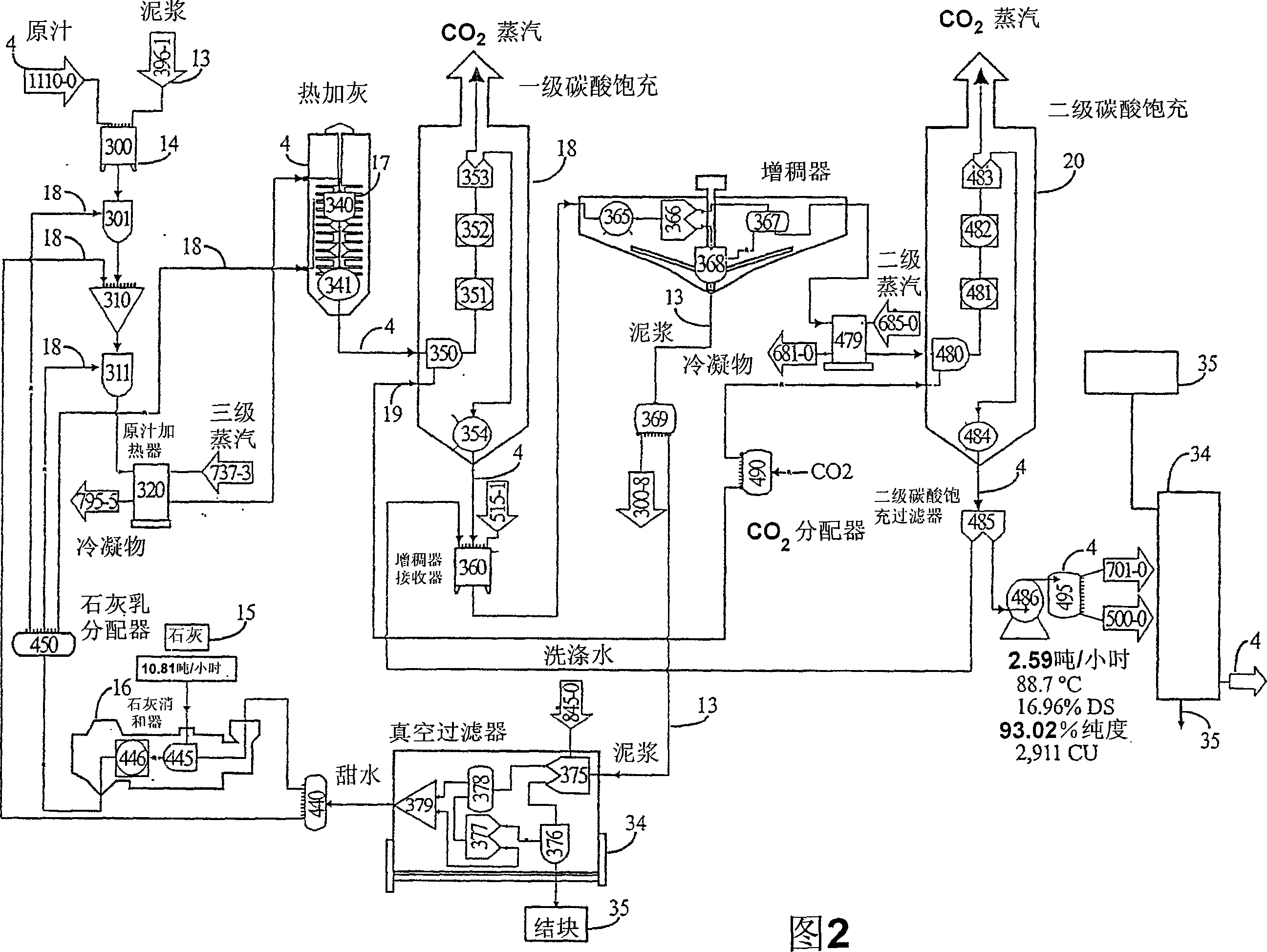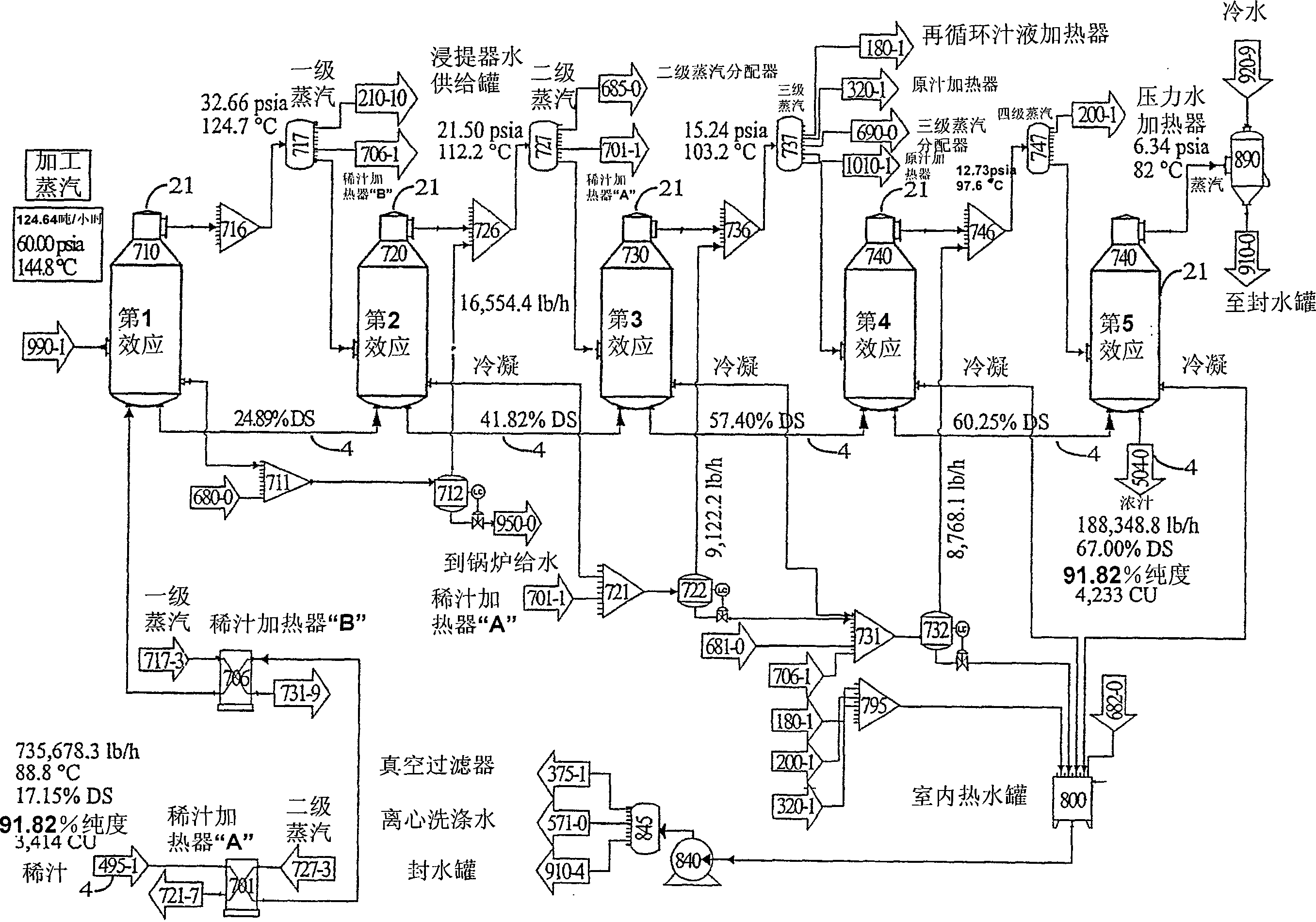Sugar production system
A sugar production and processing system technology, applied in the field of sugar processing steps for sugar processing liquid to manufacture sugar, can solve the problems of low purity, limited quantity or speed of sugar processing liquid, etc.
- Summary
- Abstract
- Description
- Claims
- Application Information
AI Technical Summary
Problems solved by technology
Method used
Image
Examples
Embodiment 1
[0101] The juice is obtained by traditional tower extraction of beets. Control and experimental groups were generated, each consisting of six equal portions of 500 mL of substantially identical infusion juice. Aliquots within the control and experimental groups were analyzed to determine the pH. The pH value of each aliquot of the extracted juice in the control group was about 6.3. Aliquots within the control group without any further treatment were titrated with 50% wt. / vol. caustic soda solution to an endpoint of 11.2 pH. Each aliquot within the experimental group was treated according to the invention, after which the pH of each aliquot was determined, and each experimental aliquot was titrated with 50% wt. / vol. caustic soda solution to End point at 11.2 pH.
[0102] The results are listed in Table 1 below. It can be understood from the table that the pH of each aliquot of juice before any treatment was about 6.3. After the treatment according to the invention of the e...
Embodiment 2
[0106] The juice is obtained by traditional tower extraction of beets. Control and experimental groups were generated, each consisting of five substantially identical 500 mL aliquots of the infusion juice. Aliquots within the control and experimental groups were analyzed to determine the pH. The pH value of each aliquot of the extracted juice in the control group was about 6.1. Aliquots within the control group without any further treatment were titrated with a 30 brix milk of lime solution to an endpoint of 11.2 pH. Each aliquot within the experimental group was treated according to the invention, after which the pH of each aliquot was determined, and each experimental aliquot was titrated to a pH of 11.2 with a 30 Brix milk of lime solution in substantially the same manner as the control group. end.
[0107] The results are listed in Table 2 below. It can be understood from the table that the pH of each aliquot of juice before any treatment was about 6.1. After the trea...
Embodiment 3
[0112] The juice is obtained by conventional tower leaching of beets and is treated according to the invention using the embodiment shown in Figures 12 and 13 with a position between the stirrer and the lime mixer. The leach juice is dispersed at a rate of approximately 100 cubic feet per minute into an atmospheric flow (upstream path 72 inches by 72 inches, counterflow path height approximately 144 inches) generated at a rate of approximately 400 cubic feet per minute. A variety of substances were transferred in the juice of , as identified by gas chromatography / mass spectrometry analysis shown in Tables 1 and 2 below.
[0113] table 3
[0114]
[0115] Table 3 shows the gas chromatographic analysis of samples SMBSC 1 and SMBSC 2 (condensates obtained from the gas stream after countercurrent exchange with juice as described herein), comparing the spectra of these samples with the organic compounds listed above 1-9. The gas chromatograms of the acid standard mixture sample...
PUM
 Login to View More
Login to View More Abstract
Description
Claims
Application Information
 Login to View More
Login to View More - R&D
- Intellectual Property
- Life Sciences
- Materials
- Tech Scout
- Unparalleled Data Quality
- Higher Quality Content
- 60% Fewer Hallucinations
Browse by: Latest US Patents, China's latest patents, Technical Efficacy Thesaurus, Application Domain, Technology Topic, Popular Technical Reports.
© 2025 PatSnap. All rights reserved.Legal|Privacy policy|Modern Slavery Act Transparency Statement|Sitemap|About US| Contact US: help@patsnap.com



